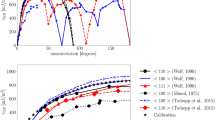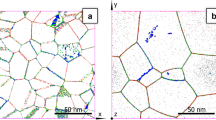Abstract
The defects appearing during the process of martensitic transformation from bcc austenite to a microtextured hcp martensite are examined, with reference to molecular dynamics simulations in zirconium. The simulations involve cooling from the high temperature austenitic bcc phase. A variety of geometric defects are identified, with the structure and dynamics being understood in terms of vicinal twin boundaries and dislocations. These defects are classified as either geometrically necessary or nanoscale effects, and the evolution of the material in response to annealing and external stress is described. The observed mechanism for twin boundary motion under applied strees involves a combination of stress concentration by preexisting sessile dislocation, causing nucleation, motion and absorption of defects in the boundary plane.
Similar content being viewed by others

References
J. W. CHRISTIAN, “The Theory of Transformations in Metals and Alloys” (Pergamon Oxford, 1975).
K.BHATTACHARYA, “Microstructure of Martensite” (OUP, Oxford, 2003).
U. PINSOOK and G. J. ACKLAND, Phys. Rev. B 58 (1998) 11252.
Idem, ibid 59 (1999) 13642.
Idem, ibid 62 (2000) 5427.
G. J. ACKLAND, S. J. WOODING and D. J. BACON, Philos. Mag. A 71 (1995) 553.
This defect is sometimes called a hexagonal translation twin: see theory of crystal dislocations FRN nabarro (Dover, 1987) pp. 202.
Our simulations are too small, our stacking fault energy too low and our cooling rates too large to see this effect. However it can be readily deduced from the energy balance between dislocation strain fields and stacking fault energy.
Technically, changing the supercell shape while maintaining the internal coordinates.
R. C. POND, A. SERRA and D. J. BACON, Acta. Materialia 47 (1999) 1441.
Author information
Authors and Affiliations
Corresponding author
Rights and permissions
About this article
Cite this article
Ackland, G.J. Simulation of martensitic microstructure. J Mater Sci 40, 3205–3208 (2005). https://doi.org/10.1007/s10853-005-2685-1
Received:
Accepted:
Issue Date:
DOI: https://doi.org/10.1007/s10853-005-2685-1



